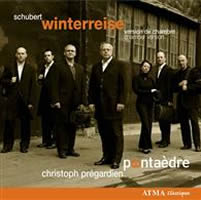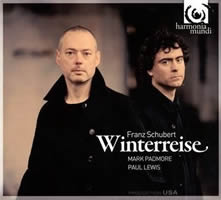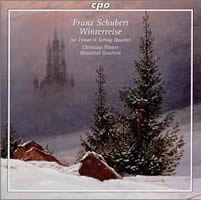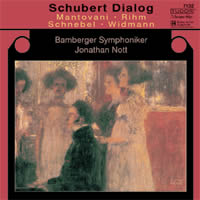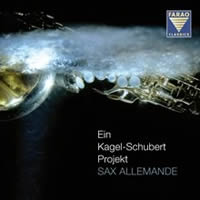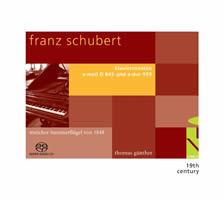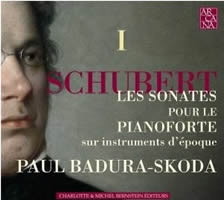Eternal Schubert and Disarrangements
|
Grant Chu Covell [November 2009.] Schubert is in the air. Recent listening clusters around two poles. It should surprise no one that arrangements and reworkings comprise the first category: I’ve glowed over Zender’s Schubert’s Winterreise which achingly prefigures Mahler, and I’ve discussed Berio, et al., who completed or reworked Schubert. The other category consists of piano music. I must confess I cannot abide Schubert on a modern piano. It has to be a fortepiano. Schubert’s chordal writing becomes clotted on a Steinway. Many pianists tend to bang, thus shouting the composer’s fine lines. I believe — in the late sonatas especially — that Schubert’s doublings were his way of compensating for the fortepiano’s narrow dynamic range. Octaves lead to excess on the modern grand. A further, perhaps more terrible confession: I like the fortepiano’s clunky sound, gentle haziness and relaxed tuning. It almost sounds prepared.
Franz SCHUBERT: Winterreise, D. 911 (1827; arr. Normand Forget, 2005). Christoph Prégardien (ten), Joseph Petric (accordion), Pentaèdre: Danièle Bourget (picc, fl, alto fl), Martin Carpentier (clar, bass clar), Normand Forget (oboe d’amore), Louis-Philippe Marsolais (hrn, Baroque hrn), Mathieu Lussier (bsn). Atma ACD2 2546 (http://www.atmaclassique.com/). Distributed in the US by Naxos (http://www.naxos.com/). Franz SCHUBERT: Winterreise, D. 911 (1827). Mark Padmore (ten), Paul Lewis (pno). Harmonia Mundi HMU 907484 (http://www.harmoniamundi.com/). Franz SCHUBERT: Winterreise, D. 911 (1827; arr. Jens Josef, 2001). Christian Elsner (ten), Henschel Quartet: Christoph Henschel, Markus Henschel (vlns), Monika Henschel-Schwind (vla), Mathias Beyer-Karlshoj (vc). cpo 999 877-2 (http://www.cpo.de/). Distributed in the US by Naxos (http://www.naxos.com/). There would appear to be a modest need for Winterreise arrangements. Harmonia Mundi’s recent Padmore / Lewis release in the standard format reminds that “[Winterreise] is the greatest song-cycle ever composed.” Perhaps we can’t get enough of these 24 songs. Prégardien is no stranger to alternate accompaniments. On Atma, he fronts a wind quintet plus accordion, a combination that suggests bucolic pathos. Normand Forget arranges with a light hand, avoiding obvious colors and associations. Indeed the intermittent alto flute, bass clarinet, oboe d’amore and Baroque horn add smoky hues. Prégardien sings suavely and confidently. He’s made this trip many times before. (With Andreas Staier at an 1825 Fritz, he takes the conventional route on Teldec 0630-18824-2.) Padmore’s light manner combines caution and grace. He has nothing on his calendar for spring. Even if you prefer Prégardien’s gravity and clearer diction, you can’t fault Padmore and Lewis, who turn in a compelling and serious cycle. One interpretive quirk stands out: In “Der Leiermann,” Lewis emphasizes the tritone grace note. I found myself warming up to Jens Josef’s tenor-plus-string-quartet setting somewhere around “Auf dem Flusse” before which Elsner’s unmodulated tone had not stood apart from the uninspired quartet figurations. Perhaps Zender’s treatment has spoiled me for any other Winterreise arrangement. However, I do find the wind-plus-accordion instrumentation more fitting than the string-quartet accompaniment. The best arrangements send us back to the original with a renewed appreciation. It’s a testament to Schubert’s genius that, regardless of an arrangement’s ingredients, Winterreise rewards careful listening.
“Schubert Dialog.” Jörg WIDMANN: Lied für Orchester (2003). Wolfgang RIHM: Erscheinung, Skizze über Schubert, für 9 Streicher und Klavier ad lib. (1978). Bruno MANTOVANI: Mit Ausdruck, pour clarinette basse et orchestre (2003). Dieter SCHNEBEL: Schubert-Phantasie (Re-Visionen I5) für geteiltes grosses Orchester (1978, rev. 1989). Peter Selwyn (pno), Alain Billard (bass clar), Bamberger Symphoniker, Jonathan Nott (cond.). Tudor 7132 (http://www.tudor.ch/). Distributed in the US by Naxos (http://www.naxos.com/). “Ein Kagel-Schubert-Projekt.” Mauricio KAGEL: Der mündliche Verrat — Suite für Saxophontrio (2007). Franz SCHUBERT: Streichtrio B-Dur, Nr. 1, D. 471 (1816); Streichtrio B-Dur, Nr. 2b, D. 581 (1817). Sax Allemande: Frank Schüssler (sop sax), Arend Hastedt (alto sax), Markus Maier (bar sax). FARAO Classics B 108038 (http://www.farao-classics.de/). Distributed in the US by Qualiton (http://www.qualiton.com/). Nott’s Schubert symphony cycle with the Bamberger Symphoniker includes Schubert-inspired contemporary works. Tudor has issued two such discs, and this release’s partner, Schubert Epilog, was covered here. Widmann’s atmospheric Lied is the longest item, nearly a half-hour of modernist melancholy that sifts through Schubertian bric-a-brac. Perhaps I’m partial, but the work could just as easily be heard as a Mahlerian ode. Written in his mid-twenties, Rihm’s two-part Erscheinung grinds Schubertian affects while permitting the intrusion of a piano. Compared with Rihm’s glazed surfaces, Widmann’s appropriations seem more sincere. Mantovani positions a fidgety bass clarinet afore the orchestra which explores song accompaniment gestures from Erlkönig and elsewhere. Schnebel’s Schubert-Phantasie, one panel from a larger series which tackles Bach, Webern, Beethoven and Wagner, appropriates the first movement of the Sonata in G Major, Op. 78, D. 894 in order to create connections between Schubert, Mahler and Bruckner. Widmann and Schnebel satisfy more. Coinciding with the year of Kagel’s passing, Sax Allemande’s Kagel-Schubert-Projekt weaves arranged Schubert string-trio movements around clumps of Kagel’s capricious character pieces. Meant to describe listeners’ moods upon hearing fairy tales, Kagel’s moments musicaux were originally scored for piano. On their own, the sax trio chose Schubert for contrast; across the lineup Kagel appears to flirt with Romantic harmony. I appreciate the clarity saxophones can bring to dense counterpoint. Schubert is well served.
Franz SCHUBERT: Sonata in A minor, Op. 42, D. 845 (1825); Sonata in A major, D. 959 (1828). Thomas Günther (fortepiano). Cybele SACD 140.402 (1 SACD) (http://www.cybele.de/). Distributed in the US by Qualiton (http://www.qualiton.com/). Franz SCHUBERT: Sonata in G major, Op. 78, D. 894, “Fantasy” (1826); Four Impromptus, Op. 142, D. 935 (1827). Andreas Staier (fortepiano). Harmonia Mundi HMC 902021 (http://www.harmoniamundi.com/). “Schubert: Les Sonates pour le Pianoforte sur instruments d’époque, Vol. 1.” Franz SCHUBERT: Piano Sonatas Nos. 1, 2, 5, 6, 7, 9, 10 and 14. Paul Badura-Skoda (fortepiano). Arcana A 408 (3CDs) (http://www.arcana.eu/). Distributed in the US by Allegro Music (http://www.allegro-music.com/). Quite possibly La Folia is the only place which would scruple to mention one of Günther’s contemporary releases before contemplating his work in a more mainstream repertoire. Günther’s Schubert elicits extraordinary colors from an 1848 J.B. Streicher fortepiano. The A-minor Sonata’s first movement’s silences are well-served; the second-movement variation set rocks. The cooler A-major sonata receives a vigorous, thoughtful treatment. Cybele should nudge Günther away from Russian Futurism and contemporary works to more Schubert. Staier’s Schubert is rhapsodic and Romantic, befitting the G-major “Fantasy” sonata. While I may have Staier’s Schumann in mind, I hear this as Schubert leapfrogging Beethoven towards Brahms. Some may prefer a more classical approach in the Impromptus, e.g., Brendel on a modern piano. Well and good, but Staier’s is a fresh perspective to which the 1996 Christopher Clarke reproduction of an 1827 Conrad Graf adds zest. All fortepiano Schubert releases beg comparison with Badura-Skoda’s titanic collection, reissued on Arcana differently configured from its initial appearance. Owing to several systems in play, the sonatas’ numberings may also perplex. This three-CD set contains my favorite, the C major, D. 840, “Reliquie,” which I first came to know from Gilbert Kalish’s Nonesuch LP (H-71386). Badura-Skoda has edited his own edition (published by Henle) and completed the unfinished third and fourth movements to middling effect. The pianist’s approach can be characterized as classical as well as reliable, and a worthy benchmark. Should Günther release a few more Schubert discs, I suspect he would challenge Badura-Skoda’s primacy. Staier takes a different path around the redoubtable mountain.
[More (Dis)Arrangements, Grant Chu Covell]
[Previous Article:
Haydn Year Highlights 2.]
[Next Article:
Album Tweets 4: Late Brahms]
|
